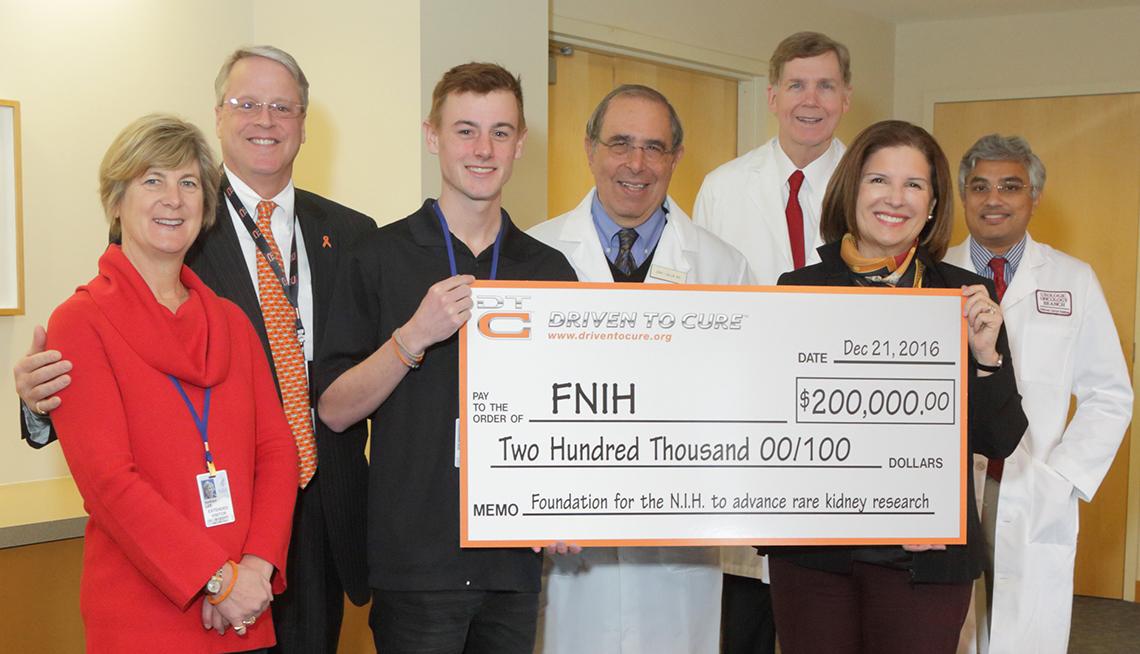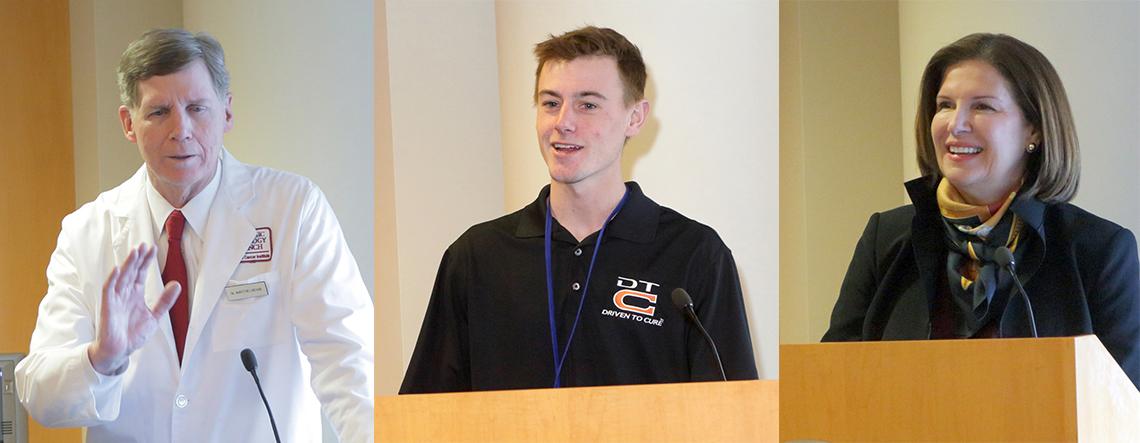Driven to Cure
Young CC Patient Donates to Cancer Research

Andrew Lee, 19, had just finished his freshman year at the University of New Hampshire when he received the devastating news. He was diagnosed with a rare form of kidney cancer; it was stage 4 and incurable. Nearly 2 years later, on a day when he was receiving one of his biweekly treatments at the Clinical Center, Lee presented a large donation to the Foundation for the NIH to support kidney cancer research.
“I was sent here, admitted to an NCI trial, which is one of the luckiest things that probably ever happened to me,” Lee said when presenting the $200,000 check at a small ceremony held recently at the CC.
“When we heard about this fantastic and generous offer, I thought this is a winning team,” said FNIH president Dr. Maria Freire. “It is about vision, hard work, fundraising and it is about courage. And those are what we need to get fantastic partnerships going.”
The contribution, collected through Lee’s fundraising efforts, will support the research of Dr. W. Marston Linehan, chief of urologic surgery and the Urologic Oncology Branch at NCI, whose work led to the development of an experimental therapy with NCI’s Dr. Ramaprasad Srinivasan that has been prolonging Lee’s life.
“Andrew, we consider you a partner,” said then-CC director Dr. John Gallin. “Volunteering to participate in one of our clinical trials is the engine that drives this place so we can discover tomorrow’s cures.”
But Lee was revved up to do even more to support cancer research. Shortly after his diagnosis, Lee’s father bought him his dream car, a Nissan GTR. “I then had the idea I could take it on the road and maybe start helping raise awareness for rare kidney cancers,” Lee said.
The young entrepreneur reached out to other car enthusiasts with his idea and founded the nonprofit Driven to Cure. Mechanics and auto detailers donated their services to enhance Lee’s GTR. Lee then took to the streets with his customized hot rod, painted bright orange, which represents kidney cancer awareness. He attended car events around the country to raise awareness and research dollars for rare kidney cancers in children and young adults.

Photo: Bill Branson
According to NCI, nearly 63,000 Americans are diagnosed with kidney and renal pelvis cancers annually and more than 14,000 die. Linehan, recently named the CC’s surgeon in chief, is pioneering cutting-edge therapies that are showing promise in treating multiple forms of kidney cancer, including HLRCC (hereditary leiomyomatosis and renal cell cancer), the rare type Lee developed.
“Without Marston’s team’s hard work, their dedication to their patients and their families, I think we would be years behind of where we are today in our understanding of rare forms of kidney cancer,” said Freire. “Their work and their vision and commitment allow us to treat these patients in this amazing facility.”
Linehan has spent more than 3 decades working in the CC. His research team found the first gene for a rare type of kidney cancer and has since found additional genes enabling them to develop therapies that target cancer gene pathways. The FDA has approved 9 drugs that target the first rare kidney cancer molecular pathway for patients with advanced cancer.
“When you study these rare cancers, they’re important for a lot of reasons,” said Linehan. “They’re important because these are people and they’re neglected disorders.”
Studying rare cancers also offers insights into other types of cancer. Linehan said, “A number of our cancers have such unique characteristics that they are central for us learning, and our colleagues learning, about other types of cancer like lung and brain cancers.

Photo: Bill Branson
“We’ve come a long way. This is a crucial time for us right now because we’re really ready; we have all sorts of information. Now that we understand these genes and are learning more and more about the gene pathways, it should just be a matter of time and resources.”
The Driven to Cure donation is a helpful resource on the road to discovery. “It takes enormous courage for someone to say I want to be a partner in this research enterprise, that I want to be part of giving of myself so that others will reap the benefit of this research,” said Freire. “Andrew, what you’re doing is nothing short of heroic. Without people like you, no new medicines and no new treatments would be possible.”
When asked how much longer he’ll be returning to NIH for treatment, Lee responded, “As long as it keeps working. Together, and with the support of many, we will find a cure one day.”
To learn more about Lee’s work, visit www.driventocure.org.
